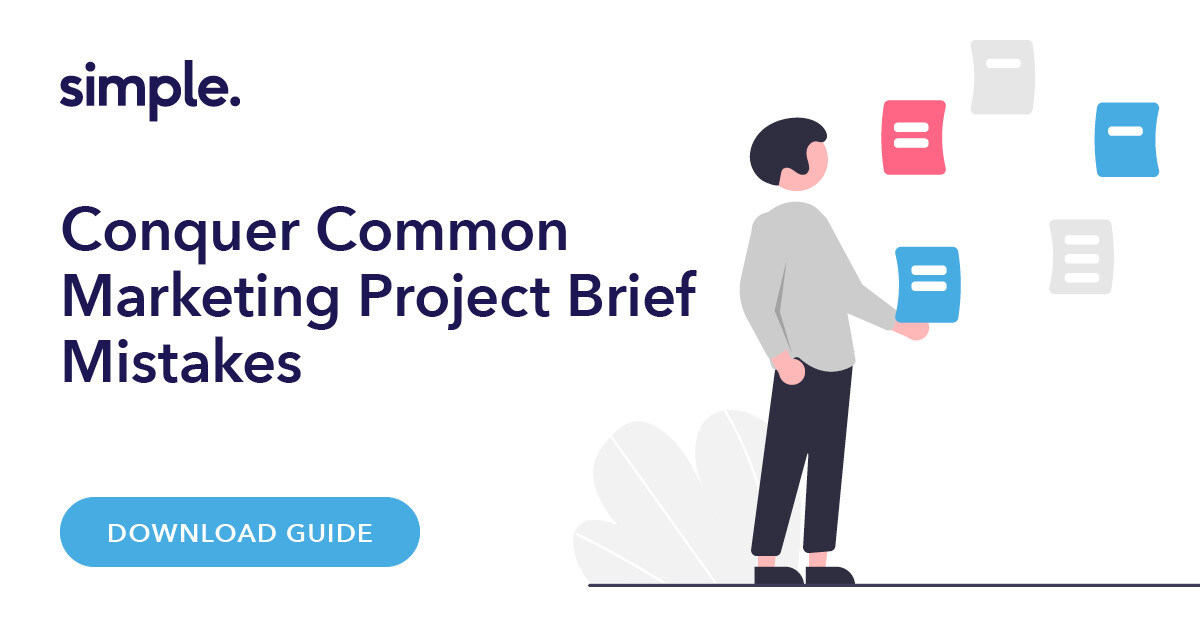How to Take the Pain Out of Managing Marketing Requests
By Jodie Byass
Managing marketing requests and project intake is one of the biggest challenges facing modern marketing teams and creative departments. Without an efficient, centralised intake process, request management becomes chaotic, slows down creative workflow, and increases compliance risks.
In today’s fast-paced, content-driven environment, marketing teams are under pressure to deliver more campaigns, faster — while juggling complex stakeholder demands, compliance requirements and limited resources. If you’re still handling requests through scattered emails, phone calls, or spreadsheets, you’re likely wasting valuable time and money. Implementing an online form template can significantly enhance team communication and workflow efficiency by organising and streamlining multiple project requests, ensuring that all necessary information is captured in a consistent and customisable manner.
In this article, we’ll explore the key challenges of marketing project intake, explain why inefficient request processes are hurting your business, and show you how to improve your creative workflow with the right tools and processes.

Why Managing Marketing Requests Is So Painful
For many marketing teams, requests can arrive from almost anywhere, making a marketing request form essential to streamline communication and improve workflow:
- Email inboxes
- Slack, Teams or other chat platforms
- Shared Google Docs or spreadsheets
- Meetings and phone calls
- Post-it notes on a whiteboard
- Even casual conversations in the lunchroom
Without a standardised intake process, this scattered approach creates major problems:
- Lack of VisibilityYou can’t see the true volume of work coming in, which makes it impossible to plan and resource your team properly.
- Poor PrioritisationWork often gets prioritised based on who asks loudest, not on business value or strategic importance.
- Incomplete BriefsMany requests arrive without critical details, leading to delays, repeated conversations, and wasted effort.
- Compliance RisksWithout clear documentation, it’s harder to manage approvals, track changes and meet marketing compliance requirements.
These problems don’t just frustrate your team — they impact deadlines, budgets, and your ability to deliver quality marketing work.
The Hidden Business Costs of Poor Request Intake
An inefficient marketing request process might seem like an operational issue, but it can have a serious impact on your bottom line. When you don't effectively manage marketing requests, it leads to disorganised and non-standardised processes that can significantly hinder your team's efficiency.
When requests are mismanaged, marketing teams suffer from:
- Wasted time chasing incomplete briefs or clarifying information.
- Delays and missed deadlines due to unclear priorities.
- Higher agency costs from late changes and rework.
- Reduced team capacity as marketers spend time on admin instead of creative work.
- Compliance breaches when approvals and sign-offs are not properly tracked.
One Simple Admation customer discovered that 80% of work requests received by their marketing team were not aligned to business objectives before they introduced a formal intake process.
Another reported that their internal creative team was spending up to 25% of their time chasing briefs, feedback and approvals — time that could have been used delivering high-value campaigns.
Research supports this. According to the 2024 State of Marketing Operations report, 43% of marketing teams say inefficient work intake processes are one of their biggest bottlenecks. Poor briefing alone is estimated to cost brands millions annually in wasted resources and missed opportunities.
Current Trends in Marketing Request Management
The need to improve request intake processes is more important than ever, driven by several trends: marketing project request forms have become essential tools for managing marketing requests effectively. These forms help organise tasks, prioritise requests, and ensure clear communication, ultimately contributing to a more productive marketing team.
1. Increased Volume of Marketing Requests
The average enterprise brand now produces over 2,000 content assets per year (Content Marketing Institute, 2024). That’s social content, video, digital ads, email campaigns, blog articles, and more — each of which requires a brief, creative input, review, and approval.
This surge in content production has led to a flood of new marketing requests. Without a formal request process or standardised marketing project request forms, teams struggle to prioritise work, leading to missed deadlines and bottlenecks. A structured intake system helps streamline this demand, ensuring requests are logged, prioritised, and resourced correctly.
2. Rising Compliance & Brand Governance Requirements
In 2025, marketing teams face growing pressure to meet legal, regulatory, and brand governance standards. From data privacy laws (like GDPR and CCPA) to strict brand guidelines in regulated industries, compliance failures can carry serious financial and reputational consequences.
Marketing compliance starts with the intake process. When request forms capture key information — such as required disclaimers, mandatory approvals, and usage rights — marketing teams reduce the risk of non-compliant content slipping through. A centralised system also creates an audit trail of marketing approvals, protecting your brand and reducing manual effort.
3. Remote & Distributed Marketing Teams
Since the pandemic, remote and hybrid work models have become the norm. Marketing and creative teams are often spread across cities, countries, or time zones. In this environment, informal request channels like in-person meetings or phone calls are no longer viable.
Marketing request form templates and digital request portals ensure that every stakeholder, no matter where they’re located, can easily submit requests in a consistent way. This enables true collaboration, visibility, and accountability across distributed teams.
4. Shift to Agile Marketing
The rise of agile marketing has seen many teams move away from rigid annual plans toward flexible, iterative workflows. But agility doesn’t mean chaos — it requires clear priorities and processes.
A formalised marketing project request form template supports agile marketing by providing a structured way to capture, review and prioritise new work. It ensures that agile teams are only taking on requests that are strategically important, clearly defined, and achievable within their capacity.
Why You Need a Centralised Marketing Request System
To overcome these challenges, you need more than a shared email inbox. You need a structured, transparent process supported by the right marketing project management software. Implementing marketing request forms can streamline communication between marketing teams and other stakeholders and departments, saving time, enhancing organisation, ensuring clarity in project requirements, and managing incoming requests efficiently.
A modern intake solution should enable you to:
- Capture all marketing requests in one place.
- Standardise brief formats so requests are complete and aligned to business objectives.
- Prioritise work based on business value, capacity and deadlines.
- Provide visibility for stakeholders to track request progress.
- Improve collaboration between marketing, creative, legal and compliance teams.
- Integrate with approval workflows and digital asset management tools.
This is exactly what platforms like Admation’s marketing project management software and Simple’s Brand Manager and Digital Asset Management solutions deliver — streamlining the entire creative workflow from intake to approvals to asset storage.
How to Improve Your Marketing Request Process
Here are six steps you can take to remove the pain of managing marketing requests using request forms:
Adopt a marketing project management solution that allows all stakeholders to submit requests via a single platform. Utilising a marketing request form within this solution can streamline the process of creating marketing requests, reducing confusion and ensuring nothing slips through the cracks.
2. Standardise Marketing Request and Briefing Forms
Use structured, customisable form templates that capture essential information such as:
- Project objectives
- Target audience
- Budget
- Timing and deadlines
- Required approvals
- Compliance considerations
This reduces the back-and-forth and ensures requests are well thought out.
One common barrier to improving intake processes is stakeholder resistance. Make it easy for stakeholders to understand why the new process exists and how it benefits them.
Provide short training, videos or FAQs explaining how to submit requests and why complete briefs are essential.
Define clear criteria for how requests will be prioritised — for example:
- Alignment to business objectives
- Revenue impact
- Compliance risk
- Available resources
Use your project management for creatives tool to make these priorities visible and transparent.
A common frustration is the back-and-forth of approvals and amendments. Choose a solution with built-in marketing approval software that makes feedback, mark-ups and approval workflows easy to manage.
Tip: Look for a tool that includes mobile-friendly approvals so stakeholders can sign off on-the-go.
Once your intake process is in place, use reporting tools to monitor:
- Volume of requests
- Time taken to complete requests
- Resource capacity
- Alignment to business objectives
This data helps you continuously improve and advocate for additional resources when needed.
What to Look for in a Marketing Request Management Solution
When evaluating tools for your marketing department, ensure your solution includes:
✅ A centralised request submission portal
✅ Customisable briefing templates
✅ Integrated approvals and compliance workflows
✅ Real-time visibility and reporting
✅ Mobile access for stakeholders
✅ Seamless integration with digital asset management software
✅ Capacity planning and resource management features
✅ User-friendly interface that encourages adoption
Beware of generalist tools like spreadsheets or generic task managers. They lack the purpose-built features needed for effective marketing request and creative project management.
Real-World Results
An Admation customer reported a marked decrease in low-value or misaligned work requests after implementing a formal intake system. By making stakeholders accountable for their requests and requiring clear, complete briefs, they freed up their creative team’s time to focus on high-impact work.
Another customer reduced their internal creative department’s project load by 15% simply by making all requests visible and subject to prioritisation — cutting out unnecessary, low-priority work. This approach aligns with a well-defined marketing strategy, ensuring that all marketing efforts are streamlined and effectively managed to support the overall business strategy.
The Bottom Line
An efficient, transparent request intake process is essential to running a successful marketing team or creative agency today. Utilising a structured request form ensures that all necessary information is captured and organised, streamlining the submission of requests related to various marketing activities. Without it, you’ll continue to battle bottlenecks, wasted time, compliance risks and frustrated teams.
By investing in the right marketing project management software and embedding a structured request process, you’ll:
- Eliminate chaotic, ad hoc requests
- Improve visibility and prioritisation
- Align marketing work to business strategy
- Reduce approval delays and compliance risks
- Free up your team to focus on creative, high-value work
Next Steps
If your team is struggling with scattered requests, constant rework and unclear priorities, now is the time to streamline your intake process with a marketing project request form. This form facilitates streamlined communication and ensures that all necessary details are gathered before starting a project.
Book a free demo today to see how Admation’s marketing project management platform can help you simplify marketing requests, manage creative projects efficiently, and improve marketing compliance.
To explore this topic further, download our Guide - Conquer Common Marketing Project Brief Mistakes - it's filled with practical tips and advice.

